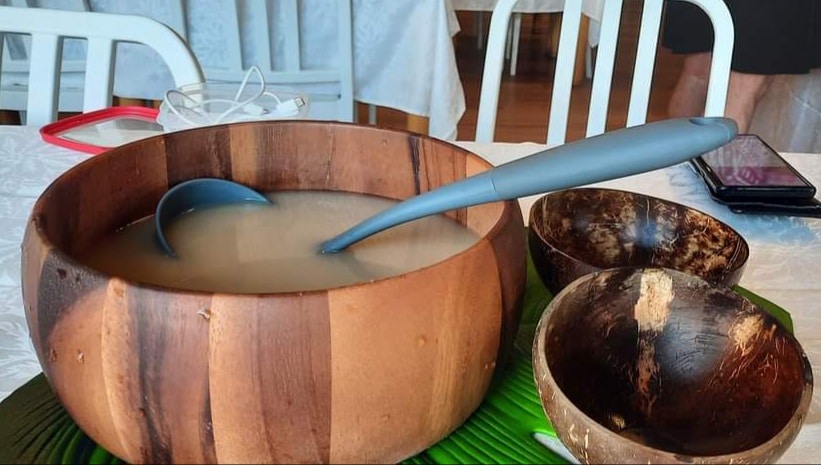The launch of Australia’s first kava lounge on Sunday, ACT community kava advocate Faonetapu Takiari said, was “a really good chance to provide a bit of education and promotion around what kava drinking is about”.
“It’s like a Polynesian cup of tea. If you visit someone’s house, we’ll sit down and have a bowl together, and then you just have a yarn.”
Kava is a psychoactive, non-alcoholic substance prepared from the root of the Piper methysticum, mixed with cold water.
Kava encourages talanoa (conversation and dialogue). Students and office workers drink it while brainstorming ideas; neighbours resolve issues and feuds over a bowl; Mr Takiari and his brother play chess. Kava facilitates catch-ups, farewells, birthdays, and meets and greets.
“It’s a universal medium for communication, for talk,” he said.
Traditionally, too, the installation of a new king or chief is marked by a formal kava ceremony; a woman will prepare kava for her prospective husband and her father; and kava is drunk at funerals, running all day and night from the beginning of the grieving to the burial, like an Irish wake.
But, Mr Takiari said, there was a lot of misinformation, misinterpretation, and misconstrued facts around kava: that it’s alcohol; that it’s a narcotic or hallucinogenic; that it’s addictive; that it’s bad for the liver. None of those are true, he explained.
“It’s definitely calming – and way more safe than many people realise. It’s one of the safest kind of substances that you can get that isn’t necessarily a conventional food.”
He points to a paper by Dr Apo Aporosa, a New Zealand health researcher, looking at the mythologising of kava.
Kava has psychoactive qualities, like coffee, Dr Aporosa found; it produces a mild relaxant soporific effect, it makes people feel cheerful and sociable, but it does not impair the reason, nor does it lead to violent behaviour.
“Kava is known as the ‘drink of peace’,” Mr Takiari said. “It will never make you aggressive; it doesn’t hype you up or stimulate you. Whether mentally, physically, or emotionally, it doesn’t ramp you up. It calms you at all times.”
Moreover, Dr Aporosa states, it reduces stress and anxiety; it has traditionally been used as a mild local anaesthetic, analgesic, antifungal, and antibacterial medicine, while it could also reduce the risk of cancer.
A 2019 Australian study of drug harms found kava was the least harmful of 22 assessed drugs: a score of 3, compared to alcohol’s 77. Similarly, Dr Aporosa noted, the World Health Organization found kava has not directly caused any deaths worldwide for the past 10 years – unlike alcohol or tobacco – and has “an acceptably low level of health risk”.
Kava in Australia
Kava was introduced to Northern Territory Indigenous communities in the 1980s as a substitute for alcohol, but in 2007, the Federal Government limited the import of kava into Australia.
Then-Health Minister Tony Abbott, the Sydney Morning Herald reported, argued that those communities consumed it at 100 times the usual rate, leading to weight loss, malnutrition, liver damage, hypertension, and skin disorders. (Dr Aporosa argued these health problems were due to sociocultural issues and other factors, not directly due to kava use.)
“It was a big shock,” Mr Takiari remembers, “going from limitless kava to all of a sudden only bringing 2kg per person – and being scrutinised or shut down if you were to drink kava in public or advertise any kind of kava.”
But the import ban worsened Australia’s relations with Pacific Island countries and the diaspora here, the Department of Prime Minister & Cabinet found.

In 2019, Prime Minister Scott Morrison launched a kava pilot program. From December 2019 to December 2021, the amount of kava passengers could bring into the country in their baggage increased from 2kg to 4kg. In December 2019, kava could be commercially imported for use as a food.
“Australia understands that kava is important to the Pacific,” Senator Zed Seselja, Minister for International Development & the Pacific, said last year. “It brings family and friends together. It’s of huge cultural importance. It’s also of large economic importance, especially when kava producers have the opportunity to export into markets such as Australia.
“What’s changed is that our Prime Minister very much listened to the concerns that were raised with him by Pacific leaders,” Senator Seselja told CW. “He accepted the cultural significance to Pacific communities. Really, it’s a show of support for our Pacific Island communities here in Canberra and right around Australia.”
In the last few months, Senator Seselja said, 45,000kg of kava have been imported in the commercial pilot.
“That’s a lot of kava, and that is fantastic. That’s a lot of community coming together and sharing.”
“It doesn’t surprise me that so much kava has already come over,” Mr Takiari said. “They were just waiting, sitting on loads and loads of plantations of kava, waiting to be able to send it to Australia.”
Pacific countries’ economies had been “very hard hit” by COVID-19, closed borders, the tourism industry shutting, and natural disasters, Senator Seselja said, but the Commonwealth’s Pacific Labour Scheme (PALM) and kava pilot would help those economies.
The Australian Government had committed $1.85 billion in aid to the Pacific in 2022–23 – “the highest it’s ever been,” Senator Seselja said – and doubled its infrastructure loans to $3 billion.



